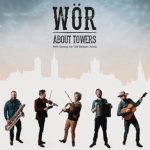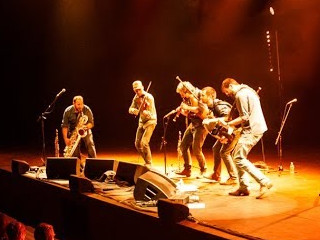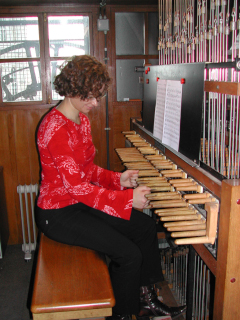


In the Low Countries around the late Middle Ages, the carillon (a set of tuned bronze bells, suspended in a large tower) functioned like a modern-day radio station for local towns. ‘Carillonneurs’ were professional musicians who would compose, collect and adapt existing melodies, and play them on the carillon for all sorts of events and occasions. Since the sound of this immense musical instrument could be heard for miles around, the carillonneurs served as the original DJs.

Today, popular music is what we hear the most on the radio, and what reaches the wider audience. If a track has a good number of ‘clicks’ or ‘likes’ on social media then it automatically generates more interest and attention. Eventually the media takes hold, plays this music and produces what we call a “hit”. It’s an ascending spiral.
A similar process happened back in the 1780s when traveling musicians brought music from elsewhere to the city. The bell tower musicians would collect the melodies and write them down in books, often with some variations to mark their own interpretation. Then the music was played to everyone in the street.
The musicians, the tunes they played, and the manuscripts they came from, became well-known, spreading far around the region. This is why nowadays you’ll find similar traditional melodies in different countries, and why the debates about where the tunes originally came from are almost impossible to resolve.
WÖR - following the steps of the past carillonneurs - take original melodies from the 18th century and remix them into their own new arrangements. With past and present instruments (bagpipes, accordion, violin, saxophones and guitar) they take the audience on a nostalgic trip through history, punctuated with modern day influences.
They think that good music is timeless and unlimited. Their traditional music is not all Belgian, Flemish or Walloon. Belgium has always been a European intersection, wide open to influences from all sides. Much of what they call ‘our traditional music’ was also very popular in France, Germany, Great Britain…
WÖR believe tradition is a living concept which is constantly retransmitted and reinterpreted. They are not creating a historically correct interpretation but a modern version to take into the next generation.
CARILLON CULTURE - PAST AND PRESENT
The carillon culture originates from two different bell traditions. There was ‘beyaerden’ (from the Flemish word ‘beieren’ - chiming). This originated at the end of the 12th century and was derived from bell-ringing. With this chiming technique, the bell did not move, instead the clapper was pulled against the inside of the bell with a rope. By 1480, chimers (or ‘beyaerders’) developed the technique to play existing melodies on these bells.

The second precursor of the carillon was the turret clock. As of the late 14th century, some of these were installed with a striking mechanism – a couple of small bells to announce the time. From around 1460, more bells were added and were programmed with musical compositions. A few decades later, carillons were found everywhere in the Low Countries. Moreover, the instruments were becoming larger and more complex.
Around 1644, the brothers François and Pieter Hemony, together with the carillonneur Jacob van Eyck, developed a technique to tune bells accurately. From then on, the carillon was an established musical instrument. Carillons mostly played musical arrangements of folk songs and dances, but from the 18th century onwards, original compositions were also written for the instrument. The most famous carillon works from that period are the eleven preludes by Matthias Vanden Gheyn, carillonneur of Leuven.
During World War I, thirteen Belgian carillons were destroyed. This caused such an outcry that the carillon was brought to international recognition, which led - after the war - to the introduction of the carillon culture in North America. Since then, the number of carillons has continued to grow internationally. In 2014 UNESCO recognised the carillon culture (in Flanders and Wallonia) as intangible cultural heritage.
CARILLON CULTURE TODAY
Today Flanders, together with the Netherlands, enjoys by far the greatest concentration of carillons in the world, with 68 bell towers and one instrument per 96,000 inhabitants. Most of them date from the 20th century, since nearly all of the historical ones disappeared through either rampage, fire or recycling.
Until well into the 20th century, it was customary to cast new carillons with bronze from old bells. A standard carillon has a range of four octaves, or 49 bells, but there are also smaller and larger ones. Carillons can vary significantly in weight, ranging from 400kg to 40 tons. A carillonneur plays the music with a baton-type keyboard, where the keys are connected to the bells’ clappers and sets them into motion.
There are twelve cities remaining with mechanical carillon barrels, but most are automated playing systems which are MIDI-controlled. Most carillonneurs are employed by their local council after their training at the Royal Carillon School ‘Jef Denyn’ in Mechelen, Belgium. In most cities, carillonneurs play one recital per week. Because the public’s taste varies, they play a mixture of classical and popular music. In the summer, carillonneurs play special concerts for audiences particularly interested in carillon music. On those occasions, the more serious carillon repertoire is played.
They also often give concerts to mark the occasion of major events, such as the death of a musical icon. Since the 90s, a new trend called carillon-plus has been on the rise. Carillon-plus is a collective term for various concert programmes of carillon music played together with other musicians. Mainly mobile carillons and indoor carillons are used for this, adding a new dimension to the carillon culture.
An important question is whether the carillon, as the oldest musical mass medium in history, still adds value to society today, or will do in the future. An important quality of the carillon is the collective listening experience it offers to the local community. It is an instrument that includes everyone indiscriminately, whilst also having the ability to create new connections within our society. In the future it would be nice to see Flanders present itself as the international carillon region-par-excellence and offer carillon music as a special attraction for tourists.
Written by Luc Rombouts - carillonneur in Tienen and Leuven and curator of Carillon Culture, Leuven.
Photo Credits:
(1ff) Wör,
(5) Liesbeth Janssens
(unknown/website).